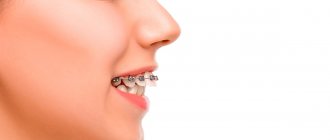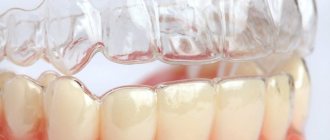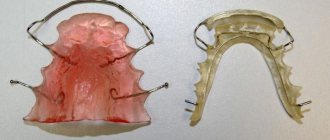If you are reading this article, it means that you are interested in improving your bite and are considering braces.
This shows that you have the determination to achieve a healthy, charming smile.
Here we have collected the questions that people most often write to us in messages.
I hope this changes your life for the better, just like it has changed the lives of thousands of other people.
Can adults get braces to correct their bite?
Anyone can correct a malocclusion, regardless of age. But in an adult, this process takes longer than in children, because skeletal growth has already stopped and hard bones are more difficult to form.
In addition, some oral health conditions may delay the installation of braces. For example, caries, periodontal disease, endocrine diseases.
Sometimes the effect of treatment is influenced by the presence of crowns and bridges. The treatment period starts from 1.5 years.
Installation of braces for children and adolescents
It is better to get braces at the age of 12-13 years, when all the permanent teeth have erupted. But in some cases, braces are placed at the age of 7-9 years, when the first permanent teeth erupt. To correct dental problems in children, the same types of braces and installation protocols are used as in adults.
In childhood and adolescence, correction occurs faster: if an adult needs several years to completely restore the normal state of the dentition, then in children this period is much shorter.
Does teeth straightening hurt?
The installation of braces itself is painless, but requires patience because it takes about an hour.
For 7-10 days, teeth may hurt when biting. The body must get used to foreign objects. In general, you live your old life, you just notice pleasant changes in yourself.
Control visits are needed to correct the process and form the correct position of the teeth. Usually after changing the arch the pain goes away within 3-7 days. It all depends on individual sensitivity.
For some, wearing braces is only unpleasant, for others, on the contrary, it is painful, and some do not feel anything.
Treatment with braces during pregnancy
Pregnancy is not a contraindication for treatment. During pregnancy, women take vitamins that support bone health. Metabolic processes in a woman’s body accelerate, and teeth move faster. Before installing braces, the orthodontist sends the patient for sanitation and professional oral hygiene. To strengthen the enamel, remineralizing therapy is carried out.
Pregnant women, unlike other patients, do not take painkillers to overcome discomfort during tooth movement at the leveling stage. During pregnancy, women often suffer from gingivitis and bleeding gums. Diseases complicate hygiene and are relative contraindications to orthodontic treatment. Sometimes, in order to avoid possible risks, bite correction is postponed until after the birth of the child.
Do braces make it difficult to eat?
Once installed, you will need to learn how to eat in them. This period takes on average 3-7 days.
At this time, give preference to soft and liquid foods. Cut fruits and vegetables into small pieces. Avoid fibrous and sticky foods.
Over time, you will be able to eat almost everything except Coca-Cola (can dissolve glue), hard foods (nuts, crackers, chocolate) and sticky sweets (chocolate, cookies or caramel bars). You should also not chew gum.
Which braces are more profitable to install?
Self-ligating and ligature braces correct the bite and correct complex dental anomalies. Non-ligating systems are more expensive, but the installation of self-ligating structures reduces the number of visits to the clinic. At a lower price for edgewise braces, the patient visits the orthodontist an average of 24 times during treatment, 2.5 – 3 years. When installing self-ligating systems, approximately 12 visits to the doctor are required. The course lasts from 1 to 2.5 years.
Clinic management is often not ready to purchase expensive systems and pay for additional training for orthodontists. Doctor A.V. Tikhonov economically substantiated the advantages of installing ligature-free braces. The orthodontist compared the rate of arch replacement during activation of self-ligating structures and traditional models with ligatures. On average, removing and installing the arch takes 8 minutes. 14 sec. on classic systems and 1 min. 21 sec. – on self-ligating ones. Usually the arches are changed on the upper and lower jaws - the duration of the manipulation is doubled.
treatment on Damon Q2
According to the researcher, taking into account the reduction in treatment time and the number of visits to the doctor, ligature-free braces are more economical for the clinic and the patient. The ergonomics of working with the ecosystem of Damon braces and additional elements reduces the appointment time and the total financial costs of the person visiting the clinic.
How often should inspections be carried out?
Every 1-2 months, it all depends on the defect and the individual structure of the patient’s teeth. During the visit, the orthodontist checks the success of the treatment and sets a vector for the arch, which determines the movement of teeth in the right direction.
Missing follow-up visits may negate the effect of previous treatment. You are also required to visit a hygienist every six months.
Braces, whether external or internal, need to be worn for an average of 1.5 years. But determining more precise timing depends on the initial situation and age of the patient. Sometimes it takes 2 years to eliminate a defect.
How do braces work?
The system consists of brackets fixed to the teeth, into the groove of which an orthodontic arch is inserted, and additional elements. On the sixth and seventh teeth, the doctor installs buccal tubes to secure the ends of the arch. The force on the tooth depends on the rigidity of the arch and the position of the arch in the bracket groove, the use of additional metal and elastic elements:
- metal ligatures;
- chains;
- springs;
- bite pads made of composite material or bite braces;
- buttons;
- hooks;
- additional arcs;
- elastics.
Damon Q2 with hook
Metal ligatures press the archwire tightly against the bracket, and springs and elastic chains create the force to move individual teeth. Using additional elements of the system, the doctor controls the impact on each tooth.
The arc straightens and pulls the bracket, the force is transmitted to the tooth and causes a process of aseptic inflammation in the surrounding tissues. Osteoclast cells destroy bone at the junction of the root and the alveolar wall. On the other side of the tooth, osteoblast cells synthesize new bone tissue. The balance of osteoblast and osteoclast activity ensures natural tooth movement. Braces direct and accelerate the physiological effect of the force of the arc and additional elements.
arc in groove Damon Q2
The operating principles of self-ligating and ligature systems differ. Self-ligating passive braces provide physiologically adequate force to move teeth due to low friction of the archwire in the closed space of the groove. In self-ligating braces with an active type of ligation, the clip and the arch press against each other. In classic ligature braces, the arch is held tightly in the groove by elastic or metal ligatures.
What to do if the bracket comes off?
In itself, this happens quite rarely, only in cases of severe crowding of teeth, since the arch puts a lot of pressure on the dentition and the lock falls off. Another option is if the patient is a nut or other solid food lover.
If you find a broken bracket, contact your orthodontist immediately. Otherwise, the teeth will begin to gradually move to their original position. Also remove elastic bands if you wear them.
The doctor sees patients with unstuck braces out of turn. It takes about 5 minutes to glue a new lock.
It also happens that the archwire flies out of the bracket grooves. You can try to get it back yourself. However, this should be done extremely carefully, without damaging the adjacent locks.
Why do they put braces?
Bracket is a bracket translated from English. Indeed, the main structural unit of modern brace systems is an arch (bracket) made of steel or various alloys. In general, it is a non-removable structure consisting of clasps glued to the teeth with special glue, through which the orthodontic arch passes. The arch is firmly fixed and is the main force that gradually aligns the dentition. It is tied to the dentition with threads or rubber rings - ligatures and secured to the molars with special metal rings. Depending on the degree of dentition disturbance, the arch is given a certain degree of tension.
To correctly place braces, the orthodontist can increase or decrease the degree of tension by changing the arch: the thicker it is, the stronger the tension.
Braces were invented at the beginning of the last century. Their design was constantly improved, new types were created, but the principle of their operation remained the same. The popularity of the method is steadily growing, especially in the modern world, where a smile plays such a big role in the life of every person. Restoring the dentition and bite reduces the risk of developing inflammatory and degenerative-dystrophic diseases of the periodontal tissues (periodontitis, periodontal disease) and premature tooth destruction.
How to brush your teeth with braces?
This is where a traditional toothbrush and toothpaste don't serve their purpose. Therefore, you will need to buy a special orthodontic brush, brushes and floss from the pharmacy. You can also use an oral irrigator if you wish.
This way you can effectively clean your teeth and the area around the locks. Teeth should be thoroughly brushed after each meal, because food debris is deposited on braces, which contributes to the development of caries and does not look aesthetically pleasing. We have repeatedly encountered patients whose teeth are more well-groomed than those of a person without braces.
Photos of teeth before and after braces
Trust in a doctor consists of many factors: reviews and recommendations from friends, a well-conducted consultation, doctor’s certificates, diplomas and awards, photos of clinical cases “before” and “after” of treatment with braces published on the Internet. Doctors actively maintain groups on social networks and blogs on clinic websites, post videos on YouTube, and post photographs with the results of orthodontic treatment.
deep bite
high crowding, flat profile
moderate crowding, asymmetry
high degree of crowding, open bite, posterior crossbite
case without removal
bilateral crossbite with a high degree of crowding of the anterior group of teeth in the upper jaw
Are braces the last stage of orthodontic treatment?
After removing braces, you need to consolidate the effect of straightening your teeth. For this purpose, retainers are made that will protect teeth from returning to their original place.
There are two types of retainers:
- Removable – transparent, plastic mouth guards. Used only at night or during a certain period.
- Non-removable - made of metal. They are installed on the back surface of the teeth using special composite materials.
The decision on the best method is made by the orthodontist. The aligners must be worn at all times during the first month, removed only for eating and brushing your teeth. On average they are worn for 2 years.
While wearing retention devices, you must visit a doctor every 3-6 months.
Removing braces
After completion of treatment, the long-awaited moment comes - removal of braces. Using special atraumatic forceps, the orthodontist peels off the bracket from each tooth with one movement of his hand. The patient hears a click and the bracket painlessly moves away from the enamel surface.
Next, the doctor grinds off the remaining glue and polishes the enamel to return the tooth to its original appearance. Grengloo bracket bonding material reduces the excessive impact of rotating instruments during polishing: removing adhesive from the tooth surface does not cause additional damage to the enamel. When there is no green material left, the enamel surface is cleaned.
Doctors from the Department of Orthodontics at the Tabriz University of Medical Sciences in Iran conducted a study and compared the differences in enamel damage after removing two brace designs - with a mesh-type base and with posts.
Researchers have scientifically substantiated the influence of the design of the bracket base on the adhesion strength to the enamel. According to the results of a study by orthodontists, at the base with columns the degree of adhesion to the enamel is higher. At the same time, braces with a mesh base cause less damage to the enamel when removed.
Doctors of the 21st century prefer systems with a mesh base to reduce the number of enamel microcracks during debonding. An example is the Damon Q and Damon Q2 self-ligating braces and the Mini Diamond ligature systems. Ormco's patented bracket base treatment makes removal safe for the enamel.
Damon Q2 with mesh base
Can you continue to live with crooked teeth?
Crooked teeth are more vulnerable to tooth decay and periodontal disease. If teeth grow incorrectly, their surfaces become excessively worn down when eating, which worsens the malocclusion. Therefore, sometimes it leads to serious diseases of the temporomandibular joints.
In addition, if you suffer from frequent headaches, chondrosis, or have tinnitus, it is better to check your bite.
How much do braces cost with installation?
Orthodontic clinics use different pricing policies. Pricing is based on the composition of the service and the frequency of payments. In some orthodontic centers, the cost of treatment includes the price of braces, while in others they pay for the system separately.
treatment on the Orthos design
There is an option for a one-time payment for the course of treatment and a scenario in which the patient pays monthly for system activation. For the patient, from the point of view of economic justification, full payment is more profitable, since the final price is not affected by fluctuations in the ruble exchange rate and changes in the price list in the clinic.
The cost of activation of ligature and self-ligating braces is approximately the same. Payment for treatment using classical systems with ligatures consists of 24 visits to the doctor and the relatively low price of the structure. Self-ligating devices are more expensive, but require the patient to go to the clinic only 12 times. Convenience of design, reduction of treatment time, the number of visits to the doctor and the time that the patient spends in the orthodontist’s chair give self-ligating devices qualitative advantages.
The cost of the course is determined by the orthodontist after diagnosis and drawing up a treatment plan.
Head of the St. Petersburg clinic “Full Order”, candidate of medical sciences Tikhonova A.V. compared the effectiveness of treatment under the scheme with a one-time payment “All inclusive” and with payment by visits.
We provide an approximate comparison of ergonomics and financial efficiency of treatment for various price options. Prices are set hypothetically, taking into account the estimated average market prices for St. Petersburg at the time of publication of the manual.
information from the book “Myths about the Damon system” by orthodontist A.V. Tikhonov
The results of the study indicate that the all-inclusive one-time payment scheme is preferable for the doctor and the patient. Payment for results allows a competent orthodontist to quickly complete treatment and increase the profitability of the practice, and the patient to receive a beautiful and healthy smile earlier.
perfect smile with Inspire Ice
Braces hurt the oral cavity, what should I do?
After installing braces, each patient receives wax for locks from the orthodontist. At the very beginning, it is worth applying it to the entire system, because the mucous membrane in the oral cavity is not yet accustomed to contact with foreign objects.
Abrasions and wounds heal very quickly. Their healing can be accelerated by using agents that promote the healing of wounds in the oral cavity.
The process of installing braces for adults
The installation of braces takes place in several stages: preparation – installation – activation. The orthodontist tells the patient in detail how braces are placed before the procedure.
Preparation
Preparation for the procedure begins with a consultation with an orthodontist. Before installing braces, the doctor always carefully examines the patient and sends him for x-rays of the upper and lower jaws. After establishing the final diagnosis, he draws up a treatment plan. First of all, the sanitation of the oral cavity is carried out: all teeth subject to treatment are treated, those not subject to treatment are removed.
After this, an impression is taken of both jaws to make a plaster model of the jaw in a dental laboratory. The doctor, together with the patient, selects the most suitable bracket system in terms of design and price.
Stages of installing braces
The installation of braces on teeth is carried out strictly in accordance with the developed protocol. She may be:
- direct - the clasps are glued directly during installation to each crown;
- indirect - first a plaster model is made, the finished structure is assembled on its basis and immediately installed in the oral cavity; This method is faster and more efficient.
Installation steps:
- Installation of a labial and jaw retractor. These mouth expanders allow access to the dentition of the upper and lower jaw. The patient can completely relax.
- Cleaning and protecting teeth. The surface of the tooth crowns is thoroughly cleaned, polished and dried.
- Installation of locks. Using special cement, a clasp is glued to the surface of each tooth. The cement is dried with a lamp with ultraviolet radiation, and its remains are removed. Braces are installed first on the upper jaw, then on the lower jaw. Indirect installation allows installations to be carried out much faster.
- Installation of the arc. After the cement has hardened, an arch is pulled through each lock and secured using a ligature (using rubber bands) or non-ligature (snaps into the grooves of the locks) method. On the lateral abutment teeth (6 or 7), the system is secured using locking rings.
The entire process of installing braces is painless and takes no more than an hour.
Activation
After installing braces, under the action of the tension force created by the arch, the teeth gradually move in a given direction and change their position. As their position in the dentition changes, the tension force of the arch decreases. This condition requires correction, called braces activation. When installing classic ligature braces, the doctor adjusts the tension force once a month. With non-ligature braces, control is required much less frequently; the orthodontist individually decides how often control should be carried out.
How to tell if braces are installed correctly
This can only be determined by a qualified specialist who has experience installing various types of braces. Experienced specialists work in the St. Petersburg dental clinic “Yulistom”, this allows for high-quality installation of braces with complete elimination of the possibility of error.
Can a doctor change treatment technology or strategy in the middle of treatment?
Maybe. if he sees that he cannot cope with the orthodontic technique he is currently using. It is optimal that all possible options are discussed between the orthodontist and the patient before treatment begins, as well as the possibility of tooth extraction. If your orthodontist says that he will begin treatment without extraction, but in the process a tactic with extraction may be chosen, then this is normal. But if the doctor announces treatment without extraction, and already during the course of treatment it becomes necessary to remove two teeth, then this is an unpleasant situation, extremely rare for a professional. In our clinical practice, this happened only 2-3 times among 2000 patients.
Sometimes there are controversial situations. For example, if the patient insisted on using the lingual technique despite other recommendations of the orthodontist, but after 1.5-2 years the desired result was not achieved, then it is better to install external braces and complete the treatment with them. Our clinic’s position is to find a compromise – if it is necessary to change technology, the patient does not suffer, including financially.
#5 After braces, stains remain on teeth
This situation can arise if you drink a lot of coffee, tea and neglect to thoroughly brush your teeth. Drinks change the natural color of teeth, and braces stick to the surface of the tooth and liquid does not get there. After removal, the space under the braces will be the same as it was during installation, but the rest of the surface may be darker.
To exclude this option, we recommend, if not giving up, then at least reducing the consumption of drinks and foods that affect the color of teeth. These include tea, coffee, carbonated drinks with dyes, red wine, pomegranate. And of course, don’t forget to brush your teeth thoroughly and visit the dentist.
What threatens those with braces?
There are several reasons why problems may arise while wearing orthodontic appliances. This:
- special treatment of enamel during installation of the structure;
- sealing areas of tooth tissue under the lock, which disrupts the supply of microelements from the outside;
- insufficient hygienic care;
- damage to the enamel when detaching braces.
First of all, you should remember about the demineralization of the enamel under the lock. This is facilitated by etching the tooth surface with acid for better adhesion of the glue to the enamel, as well as by disrupting the natural process of saturating the tooth tissue with minerals from the outside in those areas that are covered with braces. The more minerals tooth enamel loses, the more fragile and vulnerable it becomes to external influences.
The second important circumstance that should be taken into account is the creation of favorable conditions for the growth of bacteria, the formation of plaque and tartar in the places where braces are attached. Microorganisms cannot penetrate under the locks, but they actively accumulate around them. Plaques are difficult to clean from hard-to-reach places where the bristles of a toothbrush simply cannot reach them.
Special small brushes (brushes), dental floss, mouthwash, and irrigator are a must-have for any orthodontic patient. If in ordinary life all these additional means can be neglected, then in the case of braces you will have to use all of the above daily, at least twice a day. More time will be spent on hygiene than usual, which must be taken into account before installing braces. Forgetting or deliberately refusing to brush your teeth while wearing an orthodontic system is deliberately harming yourself.
The dentist will regularly monitor the patient’s oral health and carry out professional hygiene procedures. However, you should not rely only on your orthodontist. Caries and inflammatory processes in the gums can develop quite quickly, require additional financial and time costs for treatment, increase the level of discomfort from wearing braces and add dietary restrictions.











